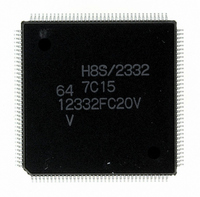D12332VFC20V Renesas Electronics America, D12332VFC20V Datasheet - Page 725

D12332VFC20V
Manufacturer Part Number
D12332VFC20V
Description
IC H8S/2332 MCU ROMLESS 144QFP
Manufacturer
Renesas Electronics America
Series
H8® H8S/2300r
Specifications of D12332VFC20V
Core Processor
H8S/2000
Core Size
16-Bit
Speed
20MHz
Connectivity
SCI, SmartCard
Peripherals
DMA, POR, PWM, WDT
Number Of I /o
106
Program Memory Type
ROMless
Ram Size
8K x 8
Voltage - Supply (vcc/vdd)
2.7 V ~ 3.6 V
Data Converters
A/D 12x10b; D/A 4x8b
Oscillator Type
Internal
Operating Temperature
-20°C ~ 75°C
Package / Case
144-QFP
For Use With
EDK2329 - DEV EVALUATION KIT H8S/2329
Lead Free Status / RoHS Status
Lead free / RoHS Compliant
Eeprom Size
-
Program Memory Size
-
Available stocks
Company
Part Number
Manufacturer
Quantity
Price
Company:
Part Number:
D12332VFC20V
Manufacturer:
Renesas Electronics America
Quantity:
10 000
- Current page: 725 of 1246
- Download datasheet (7Mb)
Section 15 Smart Card Interface
Powering On: To secure the clock duty from power-on, the following switching procedure should
be followed.
[1] The initial state is port input and high impedance. Use a pull-up resistor or pull-down resistor
to fix the potential.
[2] Fix the SCK pin to the specified output level with the CKE1 bit in SCR.
[3] Set SMR and SCMR, and switch to smart card mode operation.
[4] Set the CKE0 bit in SCR to 1 to start clock output.
15.3.8
Operation in Block Transfer Mode
Operation in block transfer mode is the same as in SCI asynchronous mode, except for the
following points. For details, see section 14.3.2, Operation in Asynchronous Mode.
Data Format: The data format is 8 bits with parity. There is no stop bit, but there is a guard time
of 2 or more bits (1 or more bits in reception).
Also, except during transmission (with start bit, data bits, and parity bit), the transmission pins go
to the high-impedance state, so the signal lines must be fixed high with a pull-up resistor.
Transmit/Receive Clock: Only an internal clock generated by the built-in baud rate generator can
be used as the transmit/receive clock. The number of basic clock periods in a 1-bit transfer interval
can be set to 32, 64, 372, or 256 with bits BCP1 and BCP0. For details, see section 15.3.5, Clock.
ERS (FER) Flag: As with the normal smart card interface, the ERS flag indicates the error signal
status, but since error signal transmission and reception is not performed, this flag is always
cleared to 0.
Rev.4.00 Sep. 07, 2007 Page 693 of 1210
REJ09B0245-0400
Related parts for D12332VFC20V
Image
Part Number
Description
Manufacturer
Datasheet
Request
R

Part Number:
Description:
KIT STARTER FOR M16C/29
Manufacturer:
Renesas Electronics America
Datasheet:

Part Number:
Description:
KIT STARTER FOR R8C/2D
Manufacturer:
Renesas Electronics America
Datasheet:

Part Number:
Description:
R0K33062P STARTER KIT
Manufacturer:
Renesas Electronics America
Datasheet:

Part Number:
Description:
KIT STARTER FOR R8C/23 E8A
Manufacturer:
Renesas Electronics America
Datasheet:

Part Number:
Description:
KIT STARTER FOR R8C/25
Manufacturer:
Renesas Electronics America
Datasheet:

Part Number:
Description:
KIT STARTER H8S2456 SHARPE DSPLY
Manufacturer:
Renesas Electronics America
Datasheet:

Part Number:
Description:
KIT STARTER FOR R8C38C
Manufacturer:
Renesas Electronics America
Datasheet:

Part Number:
Description:
KIT STARTER FOR R8C35C
Manufacturer:
Renesas Electronics America
Datasheet:

Part Number:
Description:
KIT STARTER FOR R8CL3AC+LCD APPS
Manufacturer:
Renesas Electronics America
Datasheet:

Part Number:
Description:
KIT STARTER FOR RX610
Manufacturer:
Renesas Electronics America
Datasheet:

Part Number:
Description:
KIT STARTER FOR R32C/118
Manufacturer:
Renesas Electronics America
Datasheet:

Part Number:
Description:
KIT DEV RSK-R8C/26-29
Manufacturer:
Renesas Electronics America
Datasheet:

Part Number:
Description:
KIT STARTER FOR SH7124
Manufacturer:
Renesas Electronics America
Datasheet:

Part Number:
Description:
KIT STARTER FOR H8SX/1622
Manufacturer:
Renesas Electronics America
Datasheet:

Part Number:
Description:
KIT DEV FOR SH7203
Manufacturer:
Renesas Electronics America
Datasheet:











